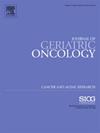The association between social vulnerability index and survival in older adults with gastrointestinal cancers – The CARE Registry
IF 3
3区 医学
Q3 GERIATRICS & GERONTOLOGY
引用次数: 0
Abstract
Introduction
Older adults represent a majority of gastrointestinal (GI) cancer cases. Social determinants of health, such as neighborhood-level social vulnerability index (SVI), are associated with frailty, a predictor of mortality. The association between social vulnerability and survival is understudied.
Materials and Methods
We evaluated 876 adults ≥60y with GI cancer enrolled in the Cancer & Aging Resilience Evaluation (CARE) Registry prior to chemotherapy. Exposure was the Center for Disease Control and Prevention's SVI in tertiles. SVI ranks census tracts between 0th and 100th percentile for lowest and highest vulnerability, respectively. Outcome was survival (enrollment to end of follow-up). Associations between SVI and survival were estimated using Cox proportional hazards models.
Results
Median age of patients was 69y, 58 % were male, 22 % were non-Hispanic Black, 30 % had colorectal, 29 % had pancreatic cancer, and 70 % had stage III/IV disease. About 44 % of participants died in median 17 months follow-up. Frailty status differed by SVI tertile (tertile 1: 26.8 %; tertile 2: 34.3 %; tertile 3: 43.4 %, p-value: <0.001). Adjusting for age, sex, and cancer type/stage, those living in neighborhoods in the highest SVI tertile had 6 % higher hazard of death (95 % confidence interval [CI]: 0.8, 1.4) and in the second-highest tertile had 8 % higher hazard of death (95 % CI: 0.9, 1.4) compared to those in the lowest tertile. This association may be driven by the SVI housing characteristics theme [tertile 2: hazard ratio (HR) 1.40 (95 % CI: 1.09, 1.79); tertile 3: HR 1.20 (95 % CI: 0.93, 1.55)].
Discussion
We did not find a statistically significant association between SVI and survival among older adults with GI cancers. Prior evidence of associations between SVI and overall area-level mortality may not reflect individual-level mortality specific to older adults. Prior evidence of associations between SVI and individual-level frailty among older adults with GI cancers suggests SVI may confer greater risk on development of frailty, which could indirectly impact survival. SVI of at-risk areas may need consideration when designing solutions to improve frailty among older adults with GI cancers, which could have a subsequent positive impact on mortality.
老年胃肠癌患者的社会脆弱性指数与生存之间的关系——CARE登记处
老年人占胃肠道(GI)癌症病例的大多数。健康的社会决定因素,如社区一级社会脆弱性指数(SVI),与脆弱有关,脆弱是死亡率的预测指标。社会脆弱性与生存之间的关系尚未得到充分研究。材料和方法我们评估了876名≥60岁的成人胃肠道癌症患者,这些患者参加了cancer &;化疗前的衰老恢复能力评估(CARE)登记。接触是疾病控制和预防中心在纺织品中的SVI。SVI将人口普查区的最低和最高脆弱性分别排在第0到第100个百分位数之间。结果是生存(入组至随访结束)。使用Cox比例风险模型估计SVI与生存率之间的关系。结果患者中位年龄为69岁,58%为男性,22%为非西班牙裔黑人,30%为结直肠癌,29%为胰腺癌,70%为III/IV期疾病。在平均17个月的随访中,约44%的参与者死亡。不同SVI分蘖的脆弱状态不同(分蘖1:26.8%;瓷砖2:34.3%;图3:43.4%,p值:<;0.001)。调整年龄、性别和癌症类型/分期后,与最低分位数的人相比,生活在SVI最高分位数社区的人死亡风险高出6%(95%可信区间[CI]: 0.8, 1.4),而生活在第二高分位数社区的人死亡风险高出8% (95% CI: 0.9, 1.4)。这种关联可能是由SVI住房特征主题驱动的[指标2:风险比(HR) 1.40 (95% CI: 1.09, 1.79);实验组3:HR 1.20 (95% CI: 0.93, 1.55)。讨论:我们没有发现SVI与老年GI癌患者生存之间有统计学意义的关联。先前关于SVI与总体区域死亡率之间关联的证据可能不能反映老年人特定的个体水平死亡率。先前的证据表明,SVI与老年GI癌症患者个体水平的虚弱之间存在关联,这表明SVI可能会增加虚弱发展的风险,这可能间接影响生存。在设计解决方案以改善患有胃肠道癌症的老年人的脆弱性时,可能需要考虑高危地区的SVI,这可能对死亡率产生后续的积极影响。
本文章由计算机程序翻译,如有差异,请以英文原文为准。
求助全文
约1分钟内获得全文
求助全文
来源期刊

Journal of geriatric oncology
ONCOLOGY-GERIATRICS & GERONTOLOGY
CiteScore
5.30
自引率
10.00%
发文量
379
审稿时长
80 days
期刊介绍:
The Journal of Geriatric Oncology is an international, multidisciplinary journal which is focused on advancing research in the treatment and survivorship issues of older adults with cancer, as well as literature relevant to education and policy development in geriatric oncology.
The journal welcomes the submission of manuscripts in the following categories:
• Original research articles
• Review articles
• Clinical trials
• Education and training articles
• Short communications
• Perspectives
• Meeting reports
• Letters to the Editor.
 求助内容:
求助内容: 应助结果提醒方式:
应助结果提醒方式:


